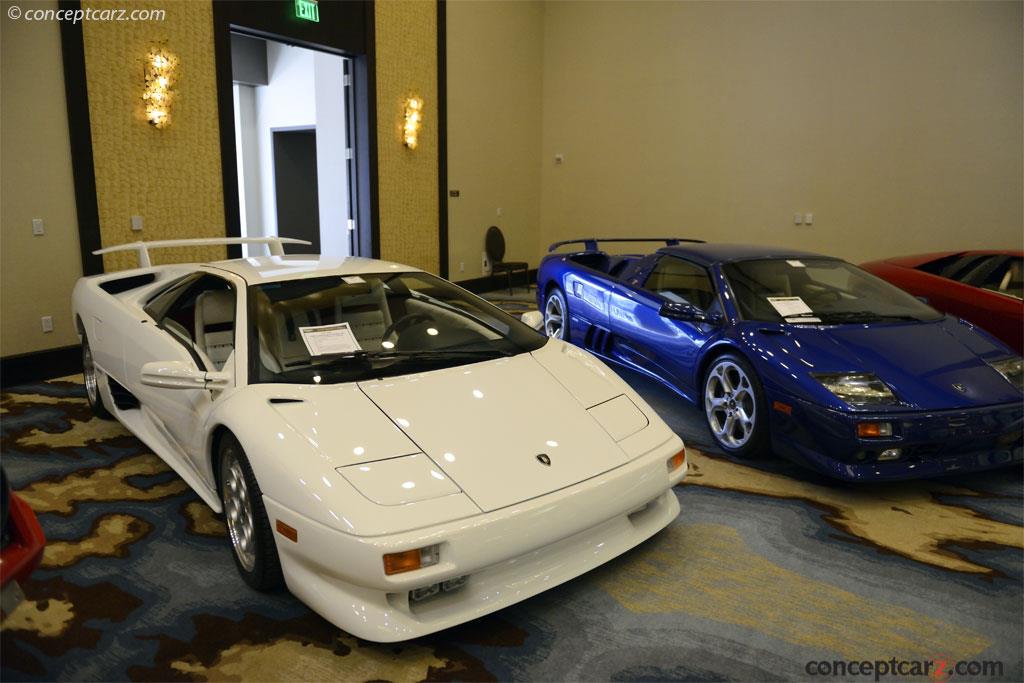In 1985 Lamborghini began designing and developing a replacement for their successful Countach model. The Lamborghini Diablo was introduced in 1990 and stayed in production until 2001. The name Diablo is Spanish meaning 'devil' and was borrowed from a type of legendary bull raised by the Duke of Veragua in the 19th century. The goal for the Countach replacement was to achieve a 315 Km/h top speed. Marcello Gandini was commissioned to design the bodywork. Chrysler purchased Lamborghini in 1987 which meant Gandini's designs had to pass Chrysler approval. Adjustments were made that took away from the aggressiveness of the vehicle and focused more on the driver and passenger comfort. The modifications did not draw drastically away from the initial designs and Gandini was satisfied with the outcome. Chryslers influence continued to the interior of the vehicle. The Italian leather seats, steering wheel, and dashboard were all adjustable. The seats could be ordered specifically to fit the driver. The stereo system was an Alpine unit, customizable to the user's preferences with offerings of either a CD or cassette player. An optional remote CD changer and sub woofer cost additional, but was still available. A Breguet clock would set the buyer back an additional $10,500 while the factory fitted luggage cost $2600. 
CoupeThe Lamborghini V-12 cylinder was enlarged to 5.7 liters and given a multi-point fuel injection system. It was placed mid-ship in the Diablo and provided power to the rear wheels. The powerplant was capable of producing nearly 500 horsepower and gave the super-car a top speed of over 325 Km/h. Zero-to-sixty took just over four-seconds.For an additional $4500, a rear wing could be added to the vehicle. The engine remained cool thanks to the rear bumper which served as a spoiler that recycled the warm air from the engine with cool air. The body was mostly comprised of aluminum alloy. The doors opened up and forward and had side windows which could be rolled down electronically. Visibility was much improved over the Countach. The side windows were designed to allow ample viewing. The rear view mirror was functional and not hindered by the engine lid. 
CoupeThroughout the years, Lamborghini made subtle improvements to the vehicle. To increase sales and attract new customers, Lamborghini introduced AWD versions, Targa editions, and limited edition variants. Limited edition versions offered customers unique customization, such as the 'Victoria's Secret' theme car. In addition to the specialty and limited editions, Lamborghini offered racing variants. A version was created to compete in the GT1 class at the 24 Hours of Le Mans. Other racing versions, such as the SVS and SV-R were factory created racing ready vehicles.In 1993 to celebrate Lamborghini's 30th anniversary of automobile production they introduced the Diablo SE 30. In an effort to reduce the overall weight, the vehicle was deprived of luxurious amenities. The brakes were enlarged and the suspension was improved, giving the driver the ability to adjust the stiffness of the vehicles suspension. The Diablo VT was introduced in 1993 and stayed in production until 1998. The VT, meaning Viscous Traction, was given an all-wheel drive system, power steering, four-piston Brembo brakes, computerized suspension system with Koni shock absorbers, and an improved interior. The suspension had two settings that could be selected by the driver. The traction-control system shifted power to the front wheels when the rear wheels lost grip. The first setting was an 'automatic' mode meaning the suspension was controlled by a computer. The 'manual' mode allowed the driver to select between four different driving selection depending on the terrain and driving conditions.
CoupeA Roadster version of the VT was introduced in 1995. It had been debuted with the coupe at the 1992 Geneva Auto Show but it took another few years before it was ready for production. It was similar to the coupe but was given a removable carbon fibre roof panel. Production continued until 1998.The Diablo SV (Sport Volce), introduced in 1995 and produced until 1998, was an optional package the included larger brakes, three-piece adjustable spoiler, revised dashboard, and an enlarged engine. The 5.7 liter twelve-cylinder engine produced 520 horsepower. The pop-up head lights were replaced with an exposed headlight system.Auto König of Germany produced a kit for the SV that added to the mechanical capabilities of the vehicle. A twin-turbocharger system increased the engines output to over 800 horsepower. To combat the extra power, the suspension and brakes received modifications.
Coupe1998 was the final year for the pop-up headlights. All models were built with the built-in headlight design.1999 brought the second versions of the Diablo VT, Diablo VT Roadster, and Diablo SV. All new was the Diablo GT. These versions were only produced for the 1999 model year. The Diablo VT was a combination of mechanical and aesthetic modifications. The pop-up headlights were replaced with exposed headlamps. The dashboard was redesigned and new wheels adorned the exterior of the vehicle. ABS finally made its way onto the Diablo. The brakes were enlarged and a new variable valve timing system (VVT) was added to the V12 engine. With 530 horsepower on tap, the Diablo VT raced from zero-to-sixty in less than four seconds. A Roadster version was available which added a removable roof.The Diablo ST was similar to the Diablo VT. Its engine featured a 530 horsepower VVT engine. The brakes were enlarged and the exposed headlamps were standard. The main distinguishing features were aesthetics.
CoupeThe Diablo GT was a limited edition version that was meant for the race track and when introduced, was the fasted production car in the world. Only eighty examples were produced, all were sold in Europe. The engine was enlarged to 6.0 liters and horsepower skyrocketed to 575. The suspension was lowered and given modifications. The brakes were enlarged and provided excellent stopping power. The weight of the vehicle was reduced wherever possible, meaning the interior was void of amenities or luxury items. Wider wheels, flared fenders, and modified bodywork gave the Diablo an aggressive stance and appearance. The third version of the Diablo VT was introduced in 2000 and produced until 2001. During its production lifespan, only 260 examples were produced. A new hybrid engine replaced the aging 5.7 liter unit. Based on the Diablo GT, the 6.0 liter VVT engine had updated software and new intake and exhaust system, resulting in 550 horsepower. Titanium connecting rods and a lighter crankshaft added to the engines improvements. Most of the vehicles were AWD however, upon customer request, rear-wheel drive could be ordered. To improve visibility at high speeds, the windshield wipers were improved. The interior and exterior of the vehicle received styling and modernization updates, including the bumper, dashboards, seats, and more. The interior was lined in leather and airbags were standard for both the driver and passenger. Carbon fibre and aluminum were used throughout the cockpit. In 2000 production of the Diablo ceased. However, Audi had purchased Lamborghini from Chrysler in the 1990's and decided to produced two special edition versions of the Diablo, the Millennium Roadster and the VT 6.0 Special Edition. The rear-wheel drive Millennium Roadster was painted in 'Millennium Metallic Silver', featured a carbon fibre rear spoiler, and given the VT roadster's body. The VT 6.0 Special Edition was offered in two colors, 'Oro Elios' (gold) and 'Marrone Eklipsis' (metallic brown). The interior color matched the exterior color. Special electrically adjustable leather seats and dashboard accompanied the Alpine stereo system and DVD audio/navigation system. Twenty-one examples in each color were created, resulting in a total of 42 produced.In September of 2001, the Diablo was replaced by the Murcielago. The SE was the final installment of the exclusive super-car, the Diablo.
by Daniel Vaughan | Dec 2005
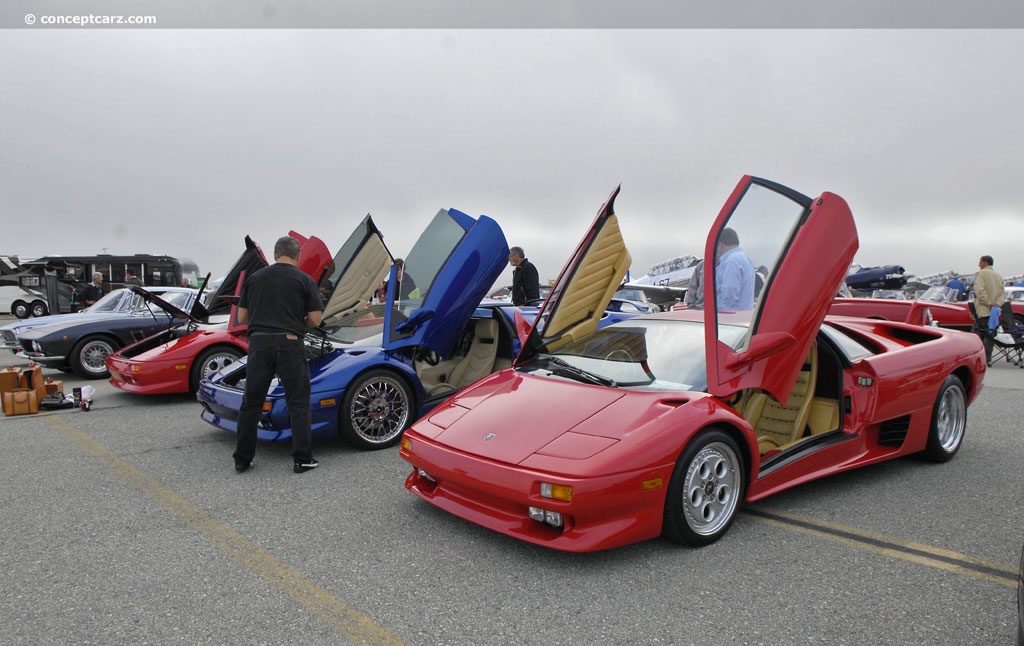
Coupe
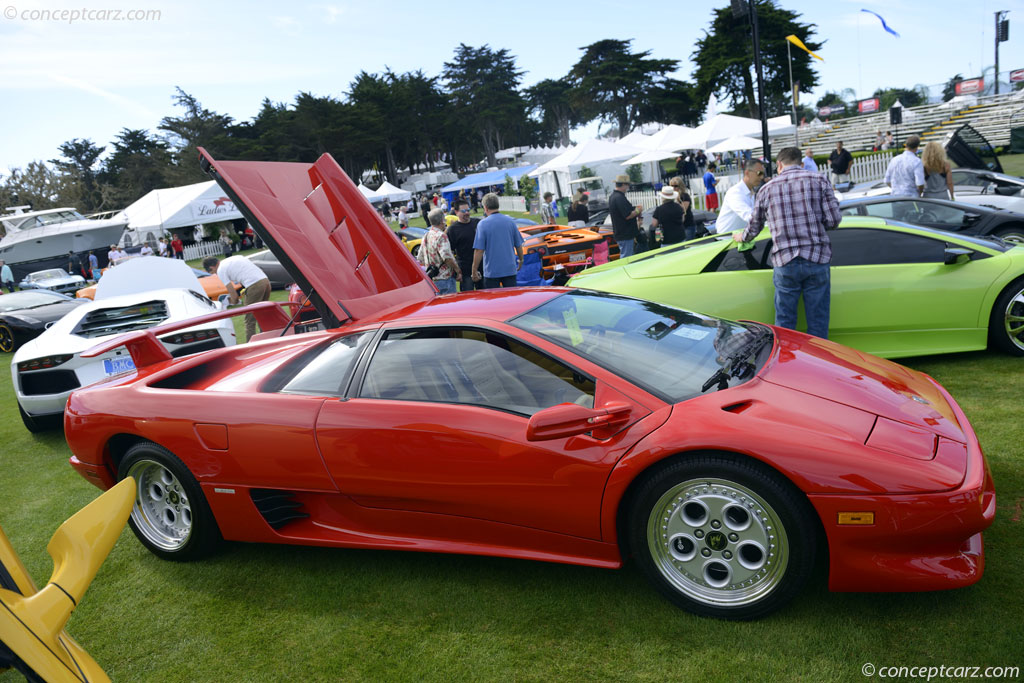
Coupe
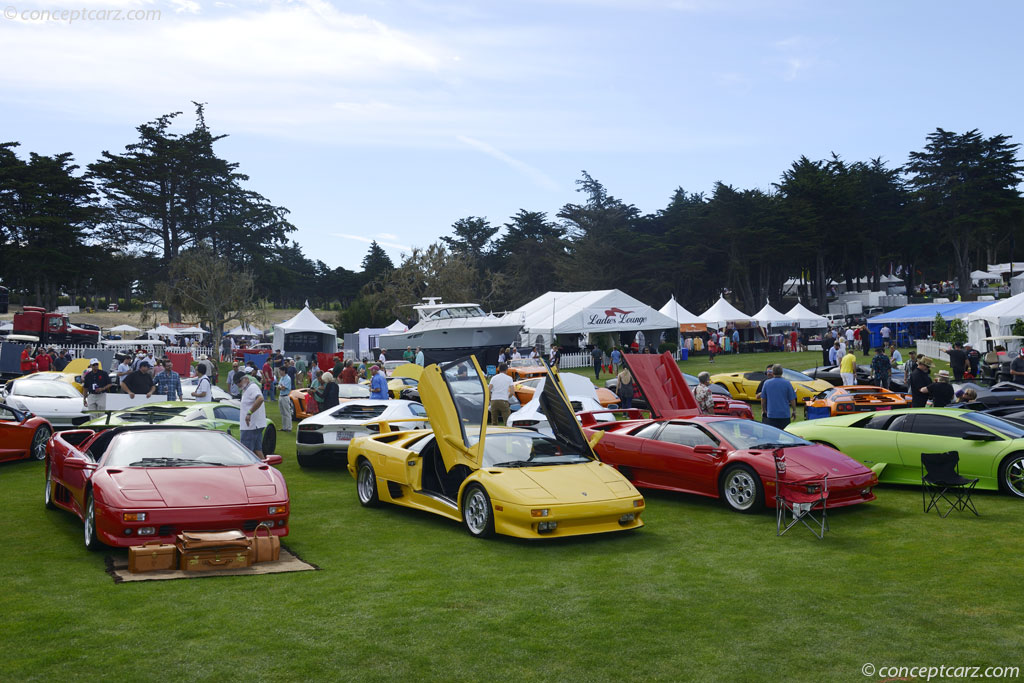
Coupe
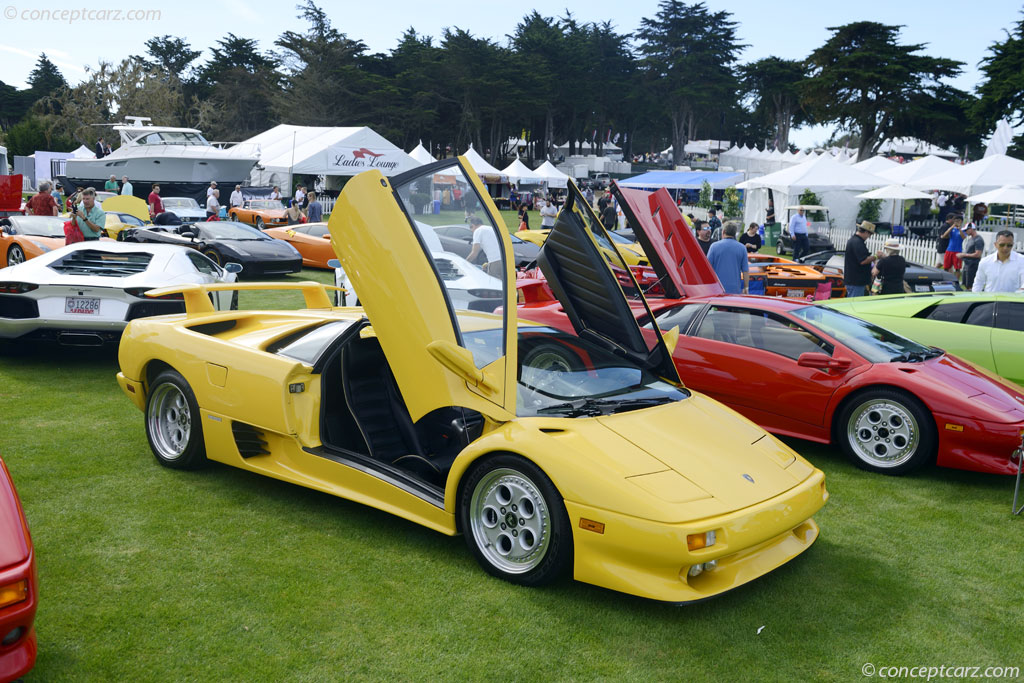
Coupe
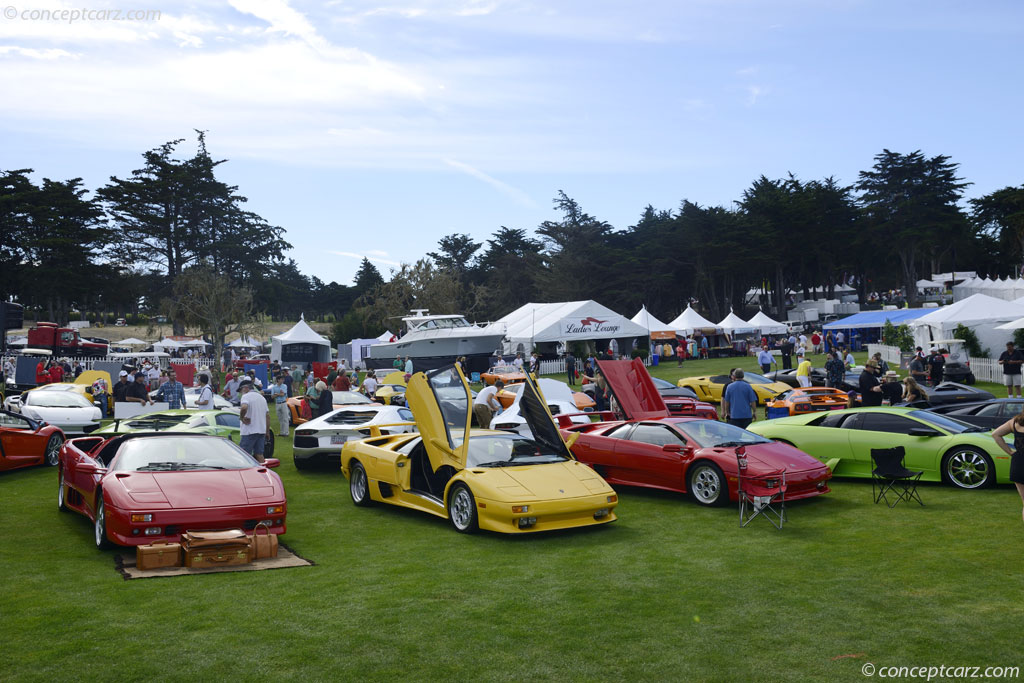
Coupe
by Daniel Vaughan | Dec 2005
Related Reading : Lamborghini Diablo History
In 1985 Lamborghini began designing and developing a replacement for their successful Countach model. The Lamborghini Diablo was introduced in 1990 and stayed in production until 2001. The name Diablo is Spanish meaning devil and was borrowed from a type of legendary bull raised by the Duke of Veragua in the 19th century. The goal for the Countach replacement was to achieve a 315 Kmh top speed.....
Continue Reading >>
Continue Reading >>
Related Reading : Lamborghini Diablo History
Replacing the Lamborghini Countach, the 2-door Lamborghini Diablo SV coupe was introduced in 1990. With a total of 2,903 units produced during its lifetime, the Diablo in the name stands for devil in Spanish and truly classifies the high-performance supercar built by Lamborghini of Italy. Unveiled on January 21, 1991, the Diablo was introduced at a base price of %24240,000. The Lamborghini Diablo....
Continue Reading >>
Continue Reading >>
Similar Automakers
Similarly Sized Vehicles
from 1994
1994 Lamborghini Diablo VT Vehicle Profiles
Recent Vehicle Additions
Performance and Specification Comparison
Price Comparison
Diablo Specification Comparison by Year
Year
Production
Wheelbase
Engine
Prices
Related Automotive News

Start Your Engines: Honda Returns to SEMA with Debut of 2022 Civic Si Race Cars Alongside Rugged Overlanding Trucks
All-New HPD Civic Si race car is a prototype for entry-level touring car racing Team Honda Research West Civic Si race car to run at legendary 25 Hours of Thunderhill Overlanding is celebrated with Passport Trai...

The Purist's Dream: 2019 Toyota 86 Blends Sports Car Fundamentals With 21St Century Performance, Comfort And Tech
New-for-2019 86 TRD Special Edition Joins Lineup as Ultimate Performance 86 with Brembo Brakes, SACHS dampers, TRD Body Kit, Michelin Pilot Sport 4 Tires, Unique Design Details, TRD Exhaust
Available with Heated Power Outside Mirrors, Keyless Ent...

2017 JAGUAR XE DEBUTS IN LOS ANGELES WITH AWD AND APPLE WATCH CONNECTIVITY
- Award-winning Jaguar XE sports sedan to arrive in U.S. Jaguar showrooms Spring 2016
- Lineup to include Jaguar XE 20d, 25t and 35t models selectively available in XE, XE Premium, XE Prestige and XE R-Sport trims
- All models offered in rear-wheel drive...

NEW VOLKSWAGEN GOLF R MAKES ITS U.S. DEBUT AT THE 2014 NORTH AMERICAN INTERNATIONAL AUTO SHOW
Most powerful production Golf ever for the North American market
New car has an estimated 290 horsepower, but is more fuel efficient than previous Golf R
EA888 TSI® 2.0-liter engine propels DSG® equipped Golf R from 0 to 62 mph in 4.9 seconds
...
BMW ANNOUNCES PRICING FOR ALL-NEW X5 SPORTS ACTIVITY VEHICLE
Woodcliff Lake, NJ – June 24th, 2013 … It isnt often that an automobile manufacturer gets to launch an entirely new vehicle segment, but thats exactly what BMW did in 1999 when it introduced the worlds first Sports Activity Vehicle – the BMW X5. Two...
